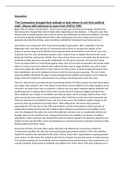Summary
Summary Practice questions for Introduction psychology (with explanations)
- Module
- Institution
This document contains the practice exam of introduction psychology with elaborate explanations of the correct answers and why other answers are wrong. Sometimes I also added some more information that is related to the questions and thus also very imporant.
[Show more]












